
Developments
All-new farm or planned expansion or relocation of an existing farm or facility, you'll find details of our current planning applications here.

We're proposing to redevelop and expand our existing Fish Holm site in Yell Sound, Shetland.
At company level, it’s part of a wider drive to streamline our existing estate into a smaller number of farms, sited in locations that offer our salmon the best growing conditions.
At sector level, it’s the first of two planning notifications – one by Scottish Sea Farms to Shetland Islands Council and the other by fellow producer Mowi to Highland Council – to help trial a new, improved licensing and consenting process for salmon farms.
Scoping stage
The EIA scoping stage was completed on 16th September 2024 and full details, including supporting documents and consultee responses, are available on the Shetland Islands Council planning portal.
You can find more details on all stages of the consenting trial in the Fish Holm Consenting Trial Stages Summary, titled ‘CTG PILOT JOINT ADVICE REPORT (STAGE 4)’.
Submission
As with all planning applications, you have the opportunity to submit a representation to the planning authority directly (in this case, Shetland Islands Council) now that we have submitted our application.
The application was submitted on 17th February 2025, so it is currently being validated the council. We will update this page once it is live on the planning portal.
The trial follows an independent review by regulatory expert Professor Russel Griggs in 2022, commissioned by Rural Affairs Secretary Mairi Gougeon, which found the current process of consenting and licensing for aquaculture to be complex, with no joined up approach and, as such, was not working ‘as well as it could.’
In the months since, a Consenting Task Group, set up by the Scottish Aquaculture Council to deliver the recommendations, has been working on a new, more coordinated process.
Pre-application
As part of the trial, the pre-application process will see the two main consenting regimes – local authority planners and the Scottish Environment Protection Agency – work together to review the submission in consultation with key stakeholders, rather than each body considering the applications separately, as currently happens.
Engagement with local residents and businesses is also key. As such, Scottish Sea Farms has been in discussion with Shetland Island Council, community councils and other marine users about the proposals.
Adding to this, we have hosted two public consultation events to provide the wider community with the opportunity to ask more about, and discuss, our proposals.
These events took place on:
You can find the full pre-application screening report on the SEPA website by clicking here, which contains responses from all the statutory stakeholders.
The proposed development is to redevelop and expand an existing consented salmon farm (Fish Holm) and relinquish one other consented site (Collafirth 3) in Yell Sound, Shetland.
Current planning permission exists for an aquaculture development at Fish Holm (planning permission FFA/ZET/015) which permits 8 x 100 m circumference pens, arranged 2 x 4 in a 50 m grid and a 10 m diameter C-Cap feed barge (200 tonne capacity) located to the southwest of the proposed pen grid.
The currently consented biomass at Fish Holm (1,910t) and Collafirth 3 (1,200t) will be consolidated into one larger farm at Fish Holm (with a proposed biomass of 6,000t).
Current consents at Collafirth 3 will be fully relinquished should this application to redevelop and expand Fish Holm be approved.
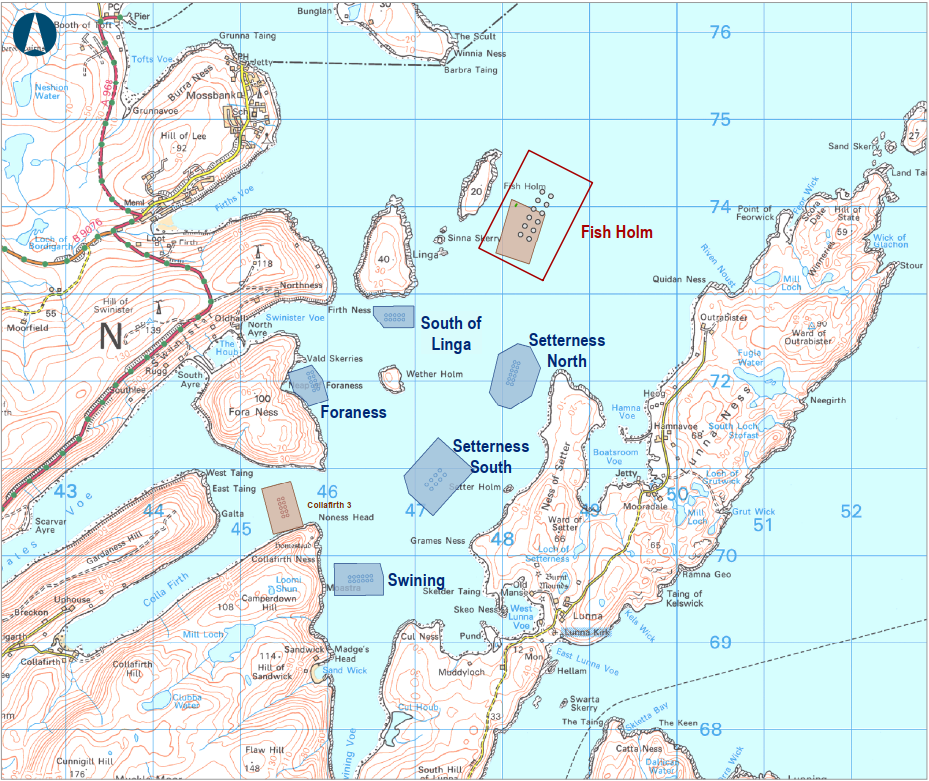
The initial layout for which planning permission was going to be applied for, and which was presented at Pre-Application Consultation and EIA Scoping, proposed a farm configuration of 12 x 200m pens in a 150m grid.
Following feedback by fisheries stakeholders, the layout was revisited to assess whether adjustments could be made to reduce the footprint of the proposal.
Multiple variations of an altered farm layout were considered, assessing pen numbers, pen size, depth of net sidewall, mooring sizes, and grid size. Following a review of viable options, the preferred layout (12 x 160m pens in a 110m grid) was selected.
This still allows for optimal stocking density in terms of both fish welfare and deposition per unit area on the seabed but results in a 23% reduction in mooring extent. There would also be a 35% reduction in the scale of the surface equipment.
A comparison of the initial layout proposed and the preferred option now presented in the EIA Report and the associated planning application is shown below:
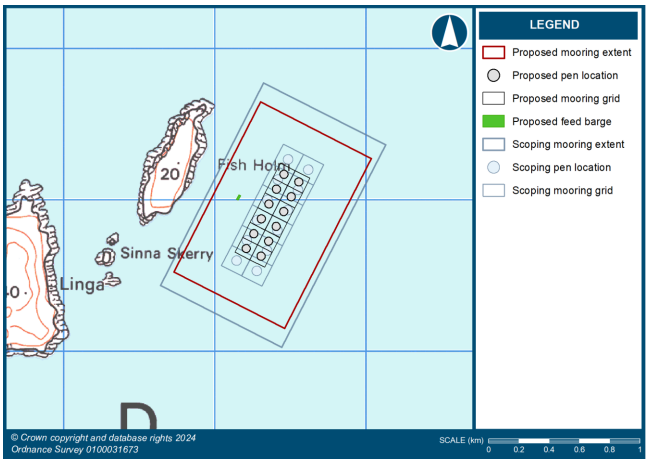
We are now proposing to redevelop and expand the existing consented salmon farm at Fish Holm by:
This would enable us to:
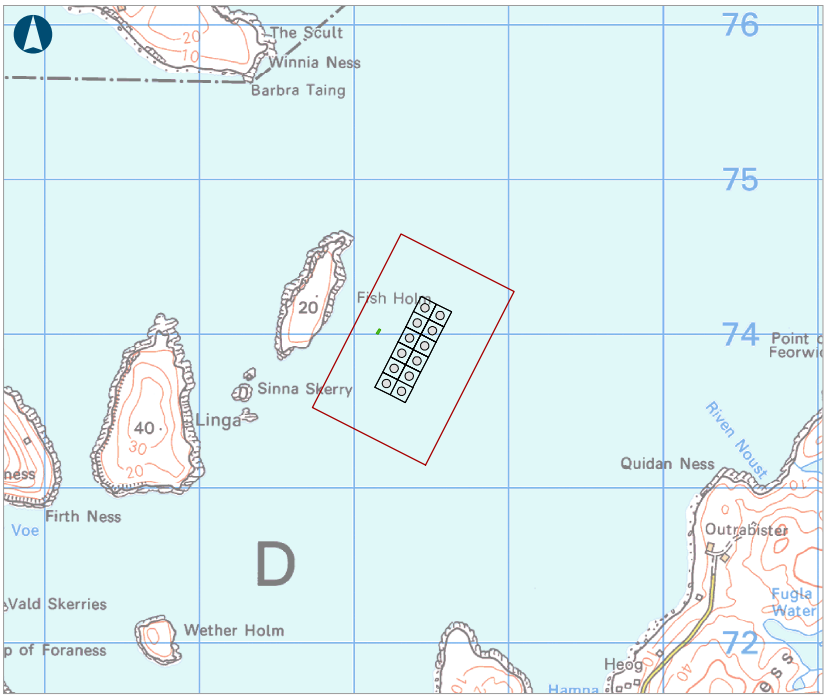
As with our other farms, each pen would be stocked to RSPCA Assured densities of just 1.5% fish to 98.5% water, with a combined maximum permitted biomass of 6,000 tonnes.
To help keep these fish safely separate from other marine life, pens would be equipped with predator defence netting systems and pole-mounted top nets.
Adjacent to the pens would be a feed barge housing a camera-monitored feeding system, office and welfare facilities for the farm team, and a store for fish feed.
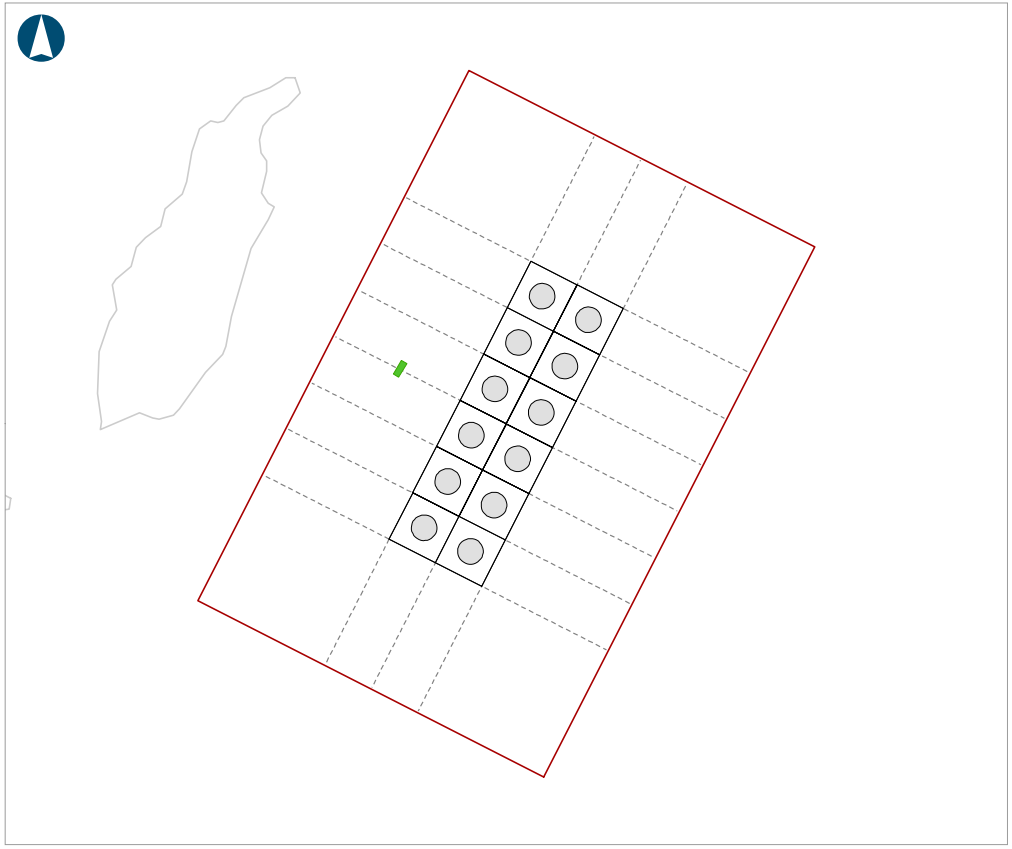
The proposed development will be equipped with the latest farm infrastructure.
This includes 160m circumference pens with pole-supported top netting system.
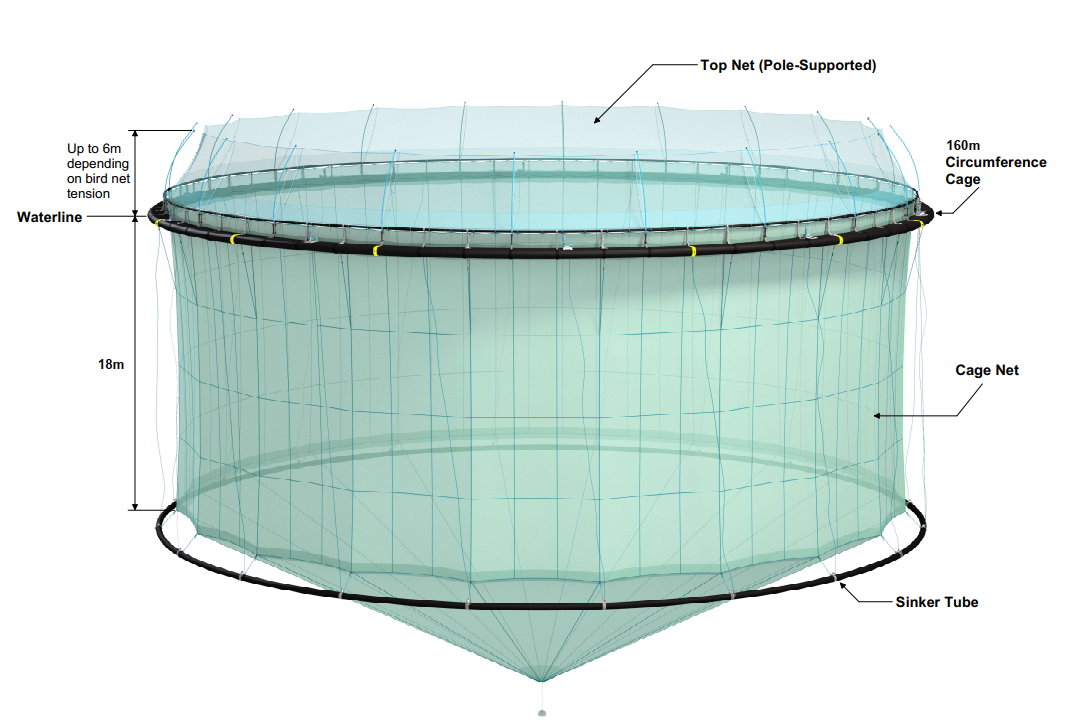
This pole-supported top netting system, designed to provide a barrier between farmed salmon and sea birds, would feature a mix of 100mm x 100mm mesh on the upper layer and 75mm x 75mm mesh on the sides. Both small enough to prevent bird access but large enough to prevent bird entanglement.
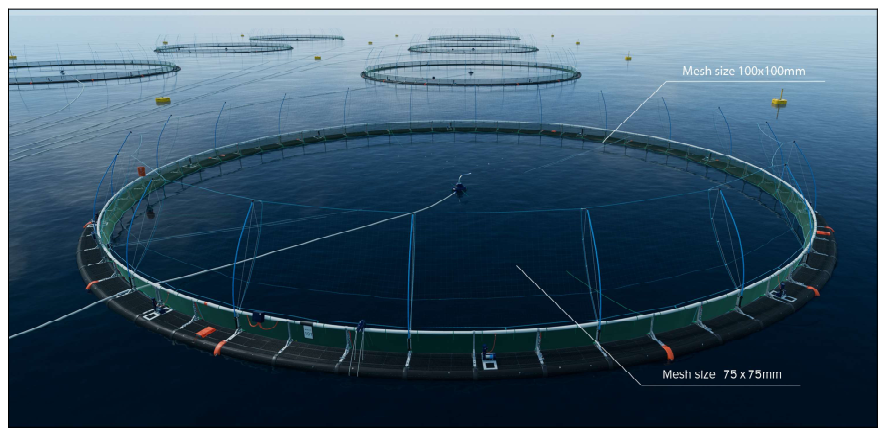
Adjacent to the pens would be a modern feed barge, featuring a boat-like design to help it blend into the local seascape.

Shore base
In addition to the feed barge stationed at Fish Holm, the farm will also be supported by our existing Setterness shore base, from where the farm team will travel to and from site.

Salmon farming is amongst the largest private employers in Shetland and the proposed redevelopment and expansion of Fish Holm will protect that:
Economic benefit
For our proposed application, the economic benefit via capital expenditure (CapEx) would be c.£11 million. The total Gross Value Added (GVA), which takes into account indirect and induced spend, would be c.£22 million.
Based on our historic expenditure cross-Shetland, it is estimated that 16.4% of the total GVA would be spent locally, meaning that approximately £3.6 million would be spent in Shetland during the construction and installation of Fish Holm.
For operational expenditure (OpEx)-related economic benefits, the total revenue spend during a 22-month production cycle is c.£33.6 million. The total annual GVA would be £24.8 million per annum (indirect and induced spend accounted for).
This means that the total spend within Shetland while Fish Holm is operating would be approximately £5.7 million per annum (based on 16.4% spent locally).
Both of these would therefore result in significant positive effects for our local supply chain in Shetland, at initial set up and during ongoing operations.
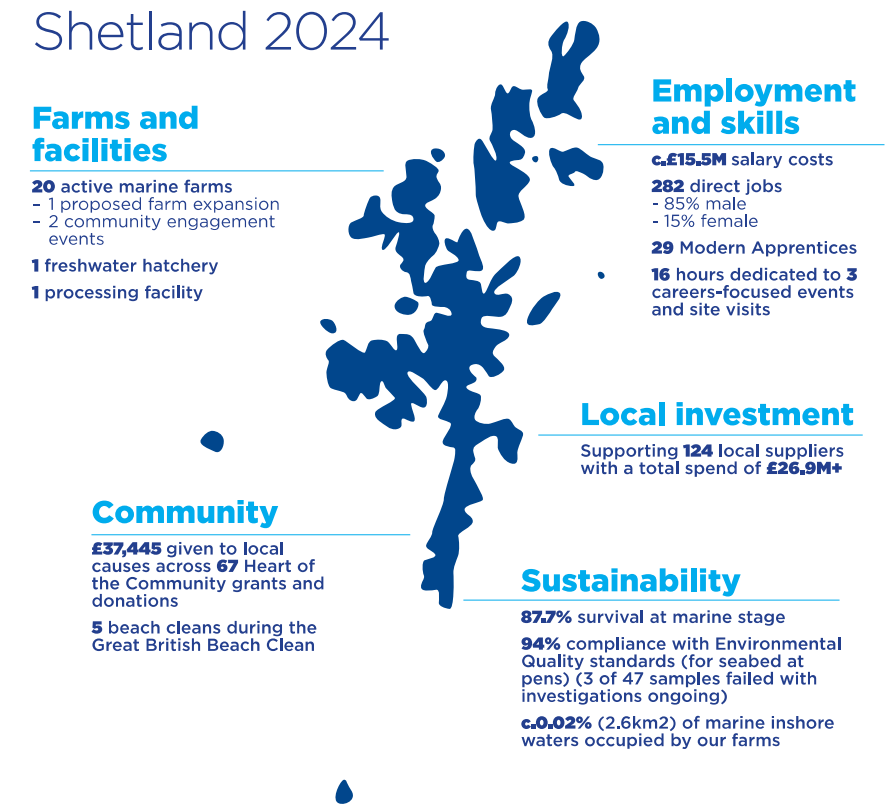
National contribution and beyond
Scottish farmed salmon is consistently one of the most valuable food exports, both in Scotland and in the UK.
Proposed farm developments such as this, aimed at enhancing fish health, welfare and survival, will further add to the volumes available for sale, helping to better meet the needs of a growing population.
Have a question related to our proposed consolidation and development of Fish Holm that’s not addressed here?
You can contact our Development team by: